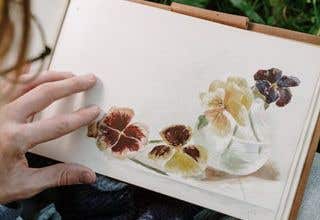In the world of acrylic painting, there's a variety of specialised vocabulary. While you don't need to learn everything, knowing some key terms can be helpful. Let's go over a few important ones.

Body
The thickness of acrylic paint is commonly referred to as its 'body'. Acrylic paint is available in different consistencies, and its body can be adjusted by incorporating thick gels to increase thickness or using water or thinner mediums to achieve a more fluid texture.
Heavy Body
Heavy body paints are a type of acrylic paint known for their thick consistency and rich texture. They contain a high concentration of pigment and have a buttery consistency that retains brush strokes and texture.
Soft Body
Soft body paints are a type of acrylic paint characterised by their smooth, flowing consistency. Unlike heavy body paints, which have a thick, buttery texture, soft body paints have a thinner consistency that allows them to flow easily from the brush.

Grade
In acrylic paint, "grade" refers to the quality level of the paint's formulation. Higher-grade acrylic paints often contain more pigment and superior binders, resulting in richer colours, better coverage, and increased lightfastness. Lower-grade acrylic paints, often labelled as "student-grade," may have less pigment and lower-quality binders, leading to less vibrant colours and potentially weaker adhesion and durability. Additionally, you may encounter classifications such as "professional-grade," indicating top-tier quality suitable for professional artists.
Flow
This to how smoothly the paint spreads across a surface. Acrylics with good flow effortlessly move from the brush or palette knife, enabling easy blending, layering, and detailed work. Conversely, paints with poor flow may feel sticky or challenging to work with, particularly for techniques requiring smooth transitions or intricate details.
Skins
Also knows as acrylic sheets, are a dried film or layer of acrylic paint that forms on a non-stick surface, such as a palette or a silicone mat, when excess paint is allowed to dry. These skins can be peeled off the surface once they are completely dry, resulting in flexible sheets of acrylic paint. Artists often use these skins for various purposes, such as collage, mixed media, or to create textured effects in their artwork. Skins can be manipulated, cut, torn, or adhered to other surfaces to add dimension and visual interest to a piece.

Impasto
Impasto acrylic painting is a technique where acrylic paint is applied to a surface in thick, textured layers. Artists use brushes, palette knives, or other tools to create raised areas of paint, resulting in a three-dimensional effect. Impasto painting allows for the manipulation of paint to create texture, depth, and visual interest in the artwork. The thick layers of paint can capture light and shadow differently, adding dynamic effects to the finished piece. This technique is popular among artists for its expressive qualities and ability to create bold, tactile surfaces.
Whether you’re a beginner or a professional, understanding acrylic painting terms is essential for artists of all levels. From grasping the viscosity of paint to knowing the difference between heavy body and soft body paints, familiarity with these terms can greatly enhance one's painting experience.
Explore our wide range of art supplies including acrylic paints, acrylic brushes, and more!
We’d love to see the artworks you create too, tag us in your posts on social media using #CreateWithEckersleys so we can celebrate your creativity!









